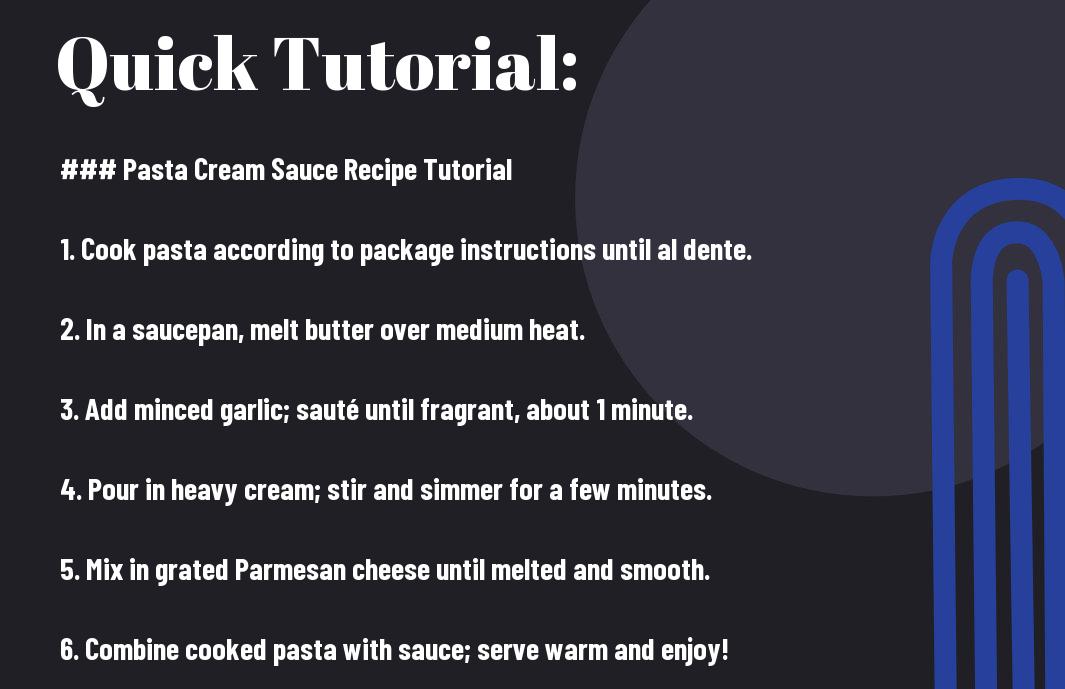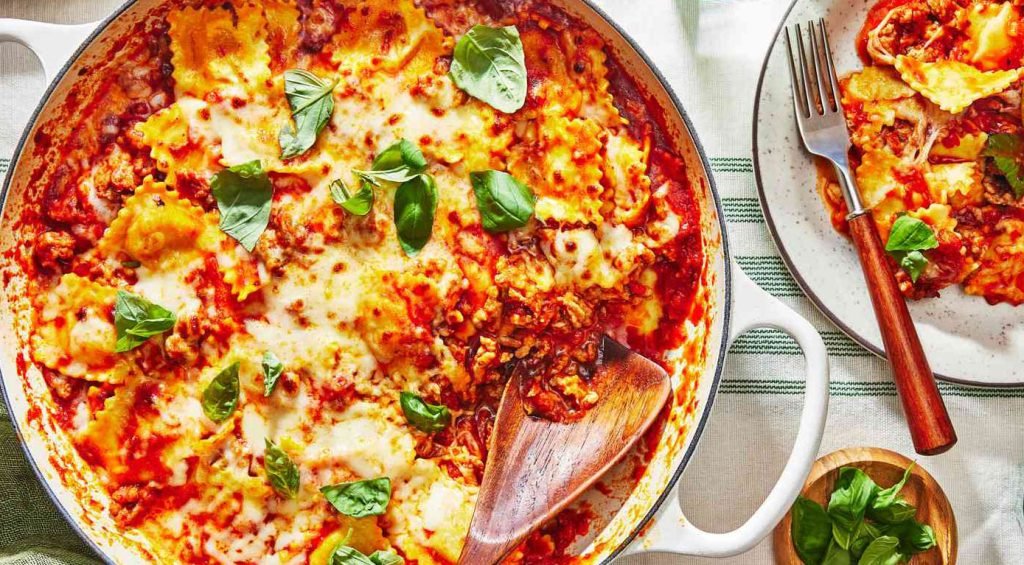Exquisite culinary creations often begin with a rich and velvety cream sauce, and this pasta cream sauce recipe is no exception. You’ll learn how to expertly combine simple ingredients to elevate your dish to restaurant-quality status in no time. With just a few necessary components, you can create a luscious sauce that clings perfectly to your pasta, providing an indulgent flavor that will impress your family and friends. Follow this guide to master your very own delectable pasta cream sauce!
Ingredients
While preparing a delicious pasta cream sauce, you will need a selection of ingredients that come together to create a rich and flavorful dish. The core elements are simple and easy to find, ensuring that you can whip up this sauce without a hassle. Gather your favorite pasta, heavy cream, cheese, and seasonings to get started.
Essential Ingredients
One of the key components of your pasta cream sauce is heavy cream, which provides the perfect creamy consistency. You will also need grated cheese, such as Parmesan or mozzarella, to enhance flavor and richness. Don’t forget garlic and seasonings like salt and pepper for a well-balanced taste.
Optional Add-ins
Ingredients such as sautéed mushrooms, spinach, or sun-dried tomatoes can elevate your cream sauce to new heights.
To customize your pasta cream sauce, consider adding protein alternatives like grilled chicken, shrimp, or sautéed vegetables. These additional ingredients not only offer variety but also contribute enhanced nutrition and flavor to your dish. Be creative! Just keep in mind, not all add-ins pair seamlessly, so choose ones that complement your base ingredients for a harmonized taste.

Preparation Methods
Clearly, preparing a delicious pasta cream sauce requires attention to detail and the right techniques. Whether you’re opting for the classic approach or exploring alternatives, each method brings a unique flavor and texture to your dish. Understanding these preparation methods can greatly enhance your culinary skills and ensure your sauce complements the pasta perfectly.
Classic Cream Sauce
Now, let’s look into the classic cream sauce, which is the foundation of many creamy pasta dishes. Start by melting butter in a pan, then add minced garlic for flavor. Gradually stir in heavy cream and bring it to a gentle simmer. Season with salt, pepper, and fresh herbs to elevate the taste. This timeless recipe creates a rich and velvety base for any pasta.
Alternative Cream Sauces
Methods for alternative cream sauces can transform your pasta experience by incorporating various ingredients and techniques. You can create lighter versions using Greek yogurt or cashew cream, catering to dietary preferences while maintaining a creamy texture. Experimenting with different flavors, like incorporating pesto or nutritional yeast, not only enhances the taste but also adds nutritional value. The versatility of these sauces allows you to adapt to your palate or available ingredients, ensuring that every meal is both delicious and satisfying.
Cooking Pasta
Many home cooks find that the process of cooking pasta can make or break a dish. To achieve perfectly cooked pasta, it’s important to use a large pot of boiling salted water. Once your pasta is added, be sure to check it regularly for the ideal texture. Aiming for *al dente* will ensure your pasta holds up beautifully in a cream sauce.
Types of Pasta
Types of pasta can greatly influence the dish you’re creating. Here’s a breakdown of some common varieties:
| Spaghetti | Long and thin, perfect for cream sauces. |
| Fettuccine | Flat and wide; complements heavier sauces. |
| Penne | Short tubes that capture sauce well. |
| Fusilli | Spiral shape, ideal for thick sauces. |
| Orecchiette | Small, ear-like shape that holds sauce. |
Knowing your pasta types can elevate your dishes, ensuring your cream sauce clings perfectly for a delightful meal.
Cooking Techniques
For best results, using the right cooking techniques is vital. Different methods can enhance the final dish, depending on the type of pasta and sauce you are using. You may want to experiment with techniques such as boiling, sautéing, or even baking pasta dishes to achieve your desired flavor and texture.
Pasta cooking techniques involve boiling your pasta in *rapidly simmering* water, which helps to cook it evenly. Always add *salt* to the water for flavor. If you plan to mix pasta with sauce afterward, reserve some *pasta water*; it can help adjust the creaminess and consistency of your sauce. Watch for *overcooking*—it alters texture and flavor significantly. You’ll want your pasta *al dente*, maintaining a slight bite that pairs wonderfully with your cream sauce!
Combining Pasta and Sauce
For the perfect pasta dish, it’s vital to combine your pasta and sauce seamlessly. Start by cooking your pasta until it’s al dente, then reserve a cup of the pasta water before draining. This starchy water can help create a creamy consistency when mixing with your sauce. Add the sauce to the pasta immediately while it’s still hot for optimal absorption of flavors. Toss them together gently, ensuring every strand is coated with the luscious cream sauce.
Mixing Techniques
Even the simplest mixing techniques can elevate your pasta dish. Use a pair of tongs or a pasta fork to combine the pasta and sauce, ensuring that you evenly distribute the sauce without breaking the pasta. If the sauce seems too thick, incorporate small amounts of the reserved pasta water until you achieve the desired creaminess. This technique not only enhances flavor but also ensures a delightful texture.
Serving Suggestions
You can take your pasta with cream sauce to the next level by considering a few serving suggestions. Pair your dish with freshly grated cheese, such as Parmigiano-Reggiano, for a rich and savory touch. Don’t shy away from adding herbs like basil or parsley for a fresh contrast. A light sprinkle of crushed red pepper can also bring vibrant heat. For a complete meal, consider serving your pasta alongside a crisp green salad or artisan bread to soak up the sauce.
Serving your pasta with cream sauce is an opportunity to impress your guests. Garnish with a sprinkle of fresh herbs and a dusting of parmesan cheese to enhance both visual appeal and flavor. Consider adding elements like sautéed mushrooms or grilled chicken for added texture and nutrients. A glass of white wine complements the creamy sauce beautifully, making it a delightful dining experience. Always aim to serve hot and fresh; this ensures that your pasta remains perfectly al dente and the sauce retains its rich, creamy consistency.
Tips and Tricks
Unlike your average pasta sauces, a creamy pasta sauce benefits from a few tips and tricks for optimal flavor and texture. Consider these suggestions:
- Use freshly grated cheese for a richer taste.
- Incorporate herbs to elevate flavor profiles.
- Adjust the thickness by controlling the cream and pasta water ratio.
Assume that with these enhancements, your creamy sauce will impress beyond expectations.
Common Mistakes
Mistakes can derail your creamy sauce, so be cautious. Overcooking your pasta can lead to mushiness, while adding too much cream without adjusting other ingredients may overwhelm the flavors. Additionally, neglecting to taste as you go can result in an unbalanced sauce, making it bland or too salty.
Enhancing Flavor
Even simple ingredients can greatly enhance the flavor of your creamy pasta sauce. By adding a splash of white wine or a squeeze of lemon juice, you can introduce acidity that brightens the dish. Freshly cracked black pepper, garlic, or sautéed onions can add layers of flavor.
Tricks like using high-quality cheese and balancing cream with the right amount of broth can make a noticeable difference. Utilizing fresh herbs like basil or parsley not only enriches taste but also adds a vibrant touch to your dish. Be mindful to avoid cooking the herbs too long, as this can diminish their aromatic properties. By combining these elements, you are ensuring a delicious sauce that truly shines in your pasta dishes.
Variations
Now that you have a basic pasta cream sauce recipe, the possibilities for variations are endless. You can incorporate various ingredients such as mushrooms, spinach, or sun-dried tomatoes to elevate the flavor. For a spicier kick, consider adding crushed red pepper flakes or a splash of white wine for added depth. Feel free to experiment with different cheeses, like Parmesan or goat cheese, to create a uniquely comforting dish every time you prepare it.
Flavor Profiles
To create distinctive flavor profiles in your pasta cream sauce, consider adding herbs and spices such as basil, thyme, or garlic. You can also experiment with citrus zest or a splash of lemon juice for brightness. For a more robust flavor, incorporate additional ingredients like smoked paprika or a hint of nutmeg, which will enhance the sauce’s richness and make your pasta dishes truly unforgettable.
Dietary Adjustments
Even if you have specific dietary needs, you can still enjoy a delicious pasta cream sauce. Substitute traditional dairy products with non-dairy alternatives such as almond milk or cashew cream for a vegan option. Additionally, you can use gluten-free pasta varieties to accommodate those who are gluten-sensitive.
Understanding your dietary preferences allows you to customize your pasta cream sauce effectively. If you’re lactose intolerant, using coconut milk or almond cream as a base can deliver a creamy texture without digestive issues. For vegans, nutritional yeast can provide a cheesy flavor, while gluten-free pasta options ensure everyone can enjoy the dish. By making these simple adjustments, you can easily cater to a variety of dietary restrictions while still savoring delightful, creamy pasta meals.
To wrap up
With this in mind, you now have the tools to create a delicious pasta cream sauce that can elevate any dish. By following the simple steps and customizing the ingredients to your taste, you can achieve a creamy, flavorful sauce that complements your favorite pasta. Enjoy experimenting with various herbs, cheeses, and vegetables to make the recipe your own, ensuring that each meal is a delightful culinary experience for you and your loved ones.


